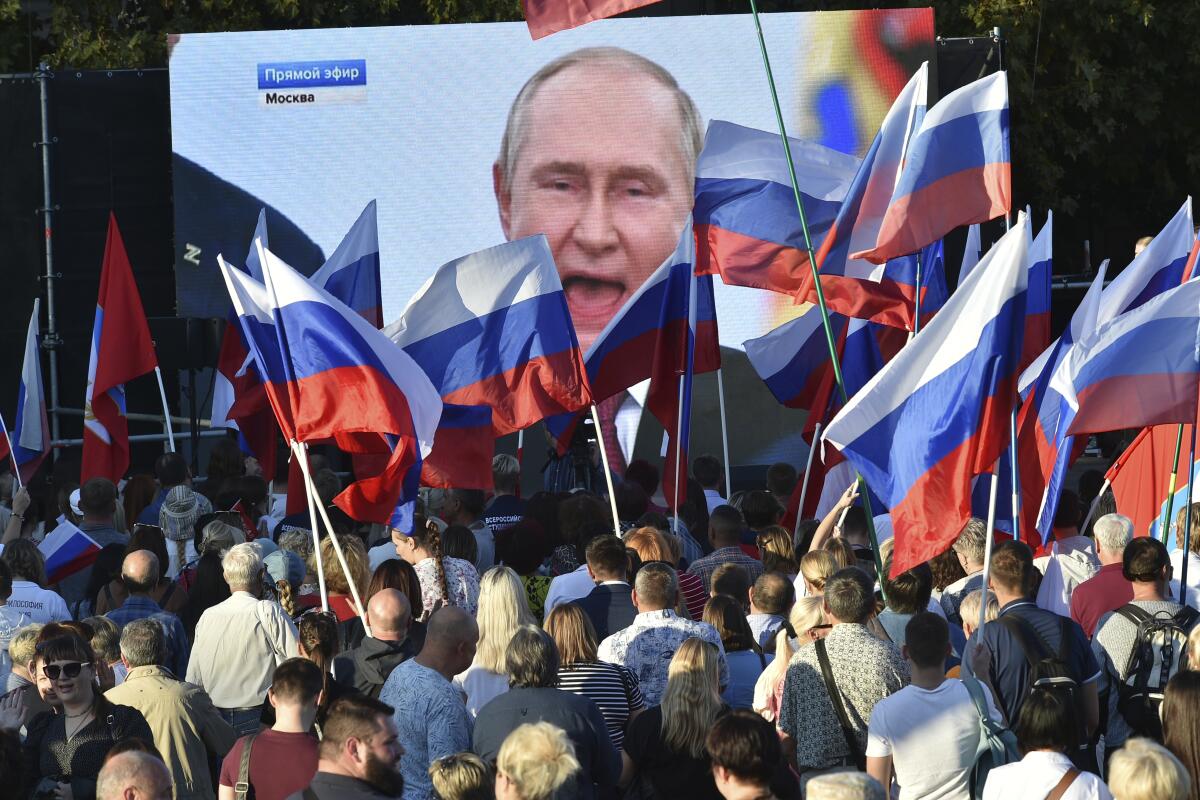Op-Ed: The next stage of Russia’s secular decline comes in 2023

After a year of big surprises, led by Russia’s invasion of Ukraine, the global spike in inflation rates, and the collapse of cryptocurrency ventures, what kind of year will 2023 prove to be? This kind of short-run question is hard to answer because repercussions of global events can spread so quickly and unpredictably. But the last 12 months highlighted one major trend that will shape what happens next, in 2023 and beyond: the decline of Russia.
Russian aggression is nothing new. Moscow has been invading other countries since the mid-1990s and has occupied parts of Ukrainian territory since 2014. But the brutality of Russia’s attacks in Ukraine since last February and the most recent phase, destroying civilian energy infrastructure, is widely seen as amounting to a war crime. It is unlikely to change the course of the war, which Russia is losing.
In the bigger picture, Russia has again entered a period of secular decline, during which it will have limited access to Western investment, technology or consumer goods. Russia’s empires have collapsed before, in 1917-18 and again when the Soviet Union imploded in 1989-91. In both cases, the collapse took a while to get going, and then proved quite complete. Of course, historically Russia has also been able to reassert control over time, and during the 1990s, by getting a lot of help from Western companies.
This time, too, we should expect a long struggle for power within Russia, with serious existential risks for the world, including who ends up controlling Russian nuclear weapons. But the more direct economic impact will be reflected in the world energy market.
Demand for Russian fossil fuels is way down. Before its 2022 invasion of Ukraine, Russia produced about 10.8 million barrels of oil per day, of which around 8 million were exported either as crude or refined products. The sharp decline in Russian economic activity means that more oil is available for export, but the European Union, the United States, and their allies are now buying crude from other suppliers — and the same will be true for refined products from February 2023.
The International Energy Agency predicts that Russian oil exports will fall to around 6 million barrels per day over 2023-24. Over the medium term, India might buy 1-2 million barrels and China could sop up the rest — assuming both countries want to become more dependent on a malevolent and unreliable partner.
Purchases by India, China, and a few others can still result in a lot of free cash flow and tax revenue for Russia. Whoever leads Russia will put much of these proceeds into building and buying weapons — including missiles with which it can hit a wide range of countries from long distance. NATO member countries are, one hopes, protected to some extent by the threat of retaliation, but Russia can be expected to engage in sabotage and other deniable attacks on Western energy infrastructure and similar vulnerable strategic targets.
During the Cold War, the Soviet Union was careful not to attack Western Europe and the U.S. too directly (and vice versa). Instead, both sides used proxy wars and other forms of pressure. This time, however, we should expect much more direct confrontation. The Russian elite have boxed themselves into a corner, with a bizarre set of beliefs — right-wing nationalism on steroids — and long-range weapons. Giving ground to these extremists will only embolden them to take more.
The need to limit over time how much cash Russia can spend on aggression is why the price cap on Russian oil exports is so important. The evidence so far is that this is working as intended.
But further measures are needed, including accelerated investments in renewable energy to reduce world demand for oil. If we continue to depend on Russia and its allies in the OPEC+ cartel, the ability to disrupt our economies will remain immense. There is now a pressing national security dimension to the energy transition.
High inflation in the 1970s had multiple causes, beginning with tight economies in the 1960s and the Vietnam War. But the problems were exacerbated by two oil price shocks, in 1973 and 1979. OPEC+ members understand that they have the power to do this again, at a time of their choosing — or the next time Russia asks for a favor.
Oil demand and supply are quite unresponsive to oil prices in the short run, but historically quite responsive over five to 10 years. In 2023 and beyond, the West needs to focus more intently on reducing demand for fossil fuels, particularly oil, and increasing the supply of alternative energy sources outside the control of Russia and OPEC.
Simon Johnson, a former chief economist at the International Monetary Fund, is a professor at MIT Sloan School of Management.
More to Read
A cure for the common opinion
Get thought-provoking perspectives with our weekly newsletter.
You may occasionally receive promotional content from the Los Angeles Times.










